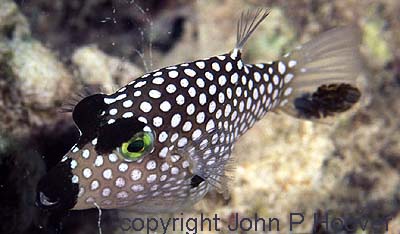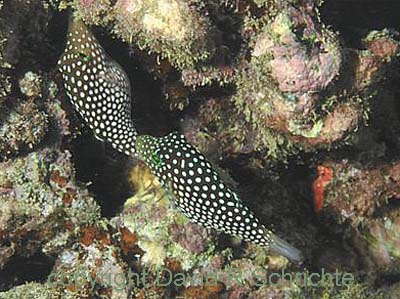|
hawaiisfishes.com
|
|
Home |
Fishes | Invertebrates |
Books | CDs
| Links |
Contact |
|
past
fishes of the month
HAWAIIAN WHITESPOTTED TOBY
|
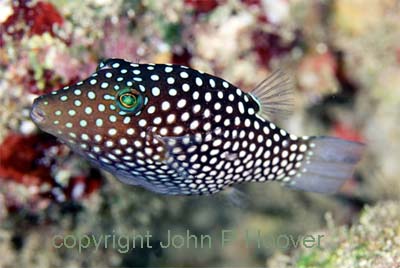 Magic Island, O`ahu. 30 ft. |
| HAWAIIAN
WHITESPOTTED TOBY Canthigaster jactator (Jenkins, 1901) Tobies, sometimes called "sharpnose pufferfish" are diminutive puffers with a somewhat elongated snout. They are generally less than 4 inches long and constitute a subfamily within the larger pufferfish family, Tetraodontidae. Out of five species of tobies in Hawai`i, this is by far the most common. It is brown with white spots. The eye is green and the body often displays a slight green fluorescence. Usually in pairs, these fish occur on hard substrate just about everywhere, both in areas of 100% coral cover and in dead silty places where little else seems to live. Some individuals have irregular black marks on the snout, body, and fins—perhaps a disease. Others are so distended with parasitic worms (nematodes) that they appear inflated. One study indicated that Hawaiian Whitespotted Tobies feed mostly on green and red algae; another showed sponges to be the main food, followed by algae and tunicates. Aquarists have observed these cute but mischievous puffers stealthily approaching other fishes and nipping their fins, leaving perfect semicircular "cookie-bites" along the edges. They also nip at the skin of resting sea turtles, especially those with tumorous growths, causing the turtles to flinch. The species name means "boaster," or "braggart," no doubt because of the fish’s ability to inflate. It attains about 3.5 inches and is endemic to the Hawaiian Islands. Two similar sister species exist, C. janthinoptera in the Indo-Pacific (excluding Hawai`i) and C. punctatissima in the Eastern Pacific, both with smaller white spots. |
|
|
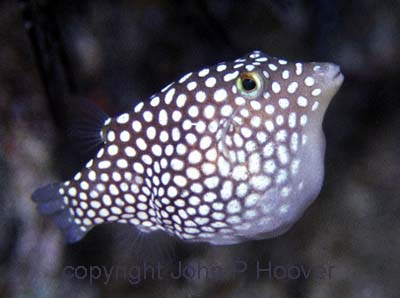 Distended by nematode worms - Marty's Reef, South Maui, 50 ft |
|
TOBY SOCIAL
ORGANIZATION AND LIFESTYLE |
| TOBY
REPRODUCTION Diving at Mäkua, O`ahu, photographer David R. Schrichte watched a pair of Canthigaster jactator apparently spawning. The fish on the right (presumably the male) pursued the fish with the swollen belly on the left (presumably the female) into a hole (photo #1). The swollen fish positioned itself repeatedly in a particular spot and trembled as if it were laying eggs (photo #2). A photo of a totally different pair at Kahe Point, O`ahu, seems to show a male (right) fertilizing eggs just laid by a still swollen female (photo #3). |
|
|
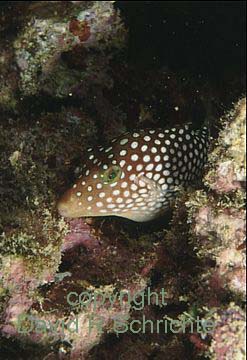 2 - Laying eggs? - Photo copyright David R. Schrichte |
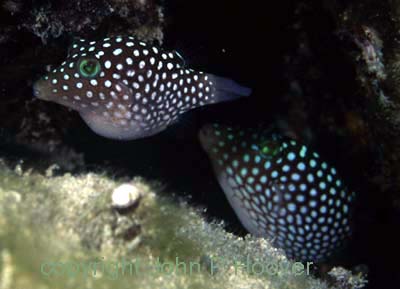 3 - Male (in back) fertilizing eggs? |
| TOBY
SUNSCREEN Observing a Whitespotted Toby under ultraviolet light, University of Hawai`i researcher Jill P. Zamzow discovered some subtle spots on the fish that were visible only when its mucus was wiped off. The mucus was apparently blocking the ultraviolet light from her lamp. In nature, she surmised, UV-absorbing compounds in the mucus probably protect the fish from the sun’s damaging radiation. The UV-blocking capability of Whitespotted Toby mucus turned out to be equal in strength to SPF 15 human sunscreen. Intrigued, Zamzow examined the mucus of 200 other Indo-Pacific reef fishes, finding sunscreen compounds in 84 percent of them. One, the Hawaiian Saddle Wrasse (Thalassoma duperrey), was even able to change the SPF factor of its mucus depending upon the depth at which it lived. |
|
|
